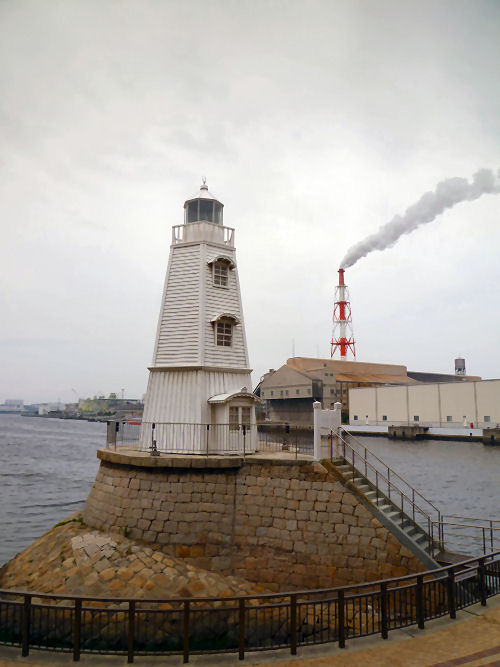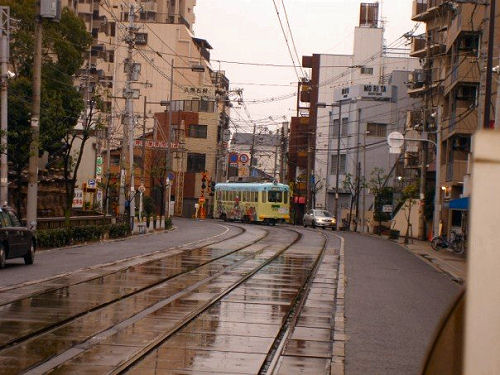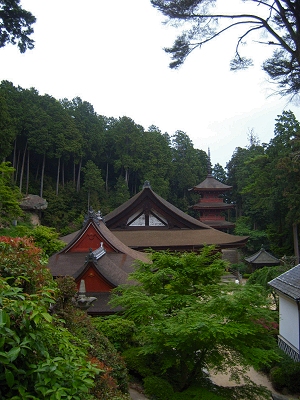Archive
Sakai: Kansai’s Lost City

Historical Old Sakai Lighthouse, with a smokestack in the background
I can’t count the number of times I have heard foreign nationals complaining about the tragic loss of traditional Kyoto. It was one of the few major cities in Japan to be spared bombing of any sort at the end of World War II, and the fact that the old wooden buildings and roadways are mostly gone is due to the demands of modernization.
But I don’t think Kyoto is the great tragedy of Kansai. I don’t even think it has really been lost, as most of its culture and traditions are still intact, its arts are still practiced, and it is respected as the cultural center of Japan by almost all, despite the considerable legacies of places such as Edo and Osaka. And regardless of its considerable size and the laws that make preservation of wooden structures difficult, Kyoto has still managed to maintain a significant amount of its architectural legacy. The real tragedy of Kansai is the city of Sakai, which has become a dreary southern-Osaka suburb and a manufacturing center. Urbanization and modernization have not only created a city that is, for the most part, run-down and depressing, its has chiseled away at the cultural legacy of Sakai to such a degree that most Japanese don’t even know of the city’s importance in Japanese history and culture.
One of the more well-known facts about Sakai is that it has historically produced the best-quality blades in Japan, and most consider it to be one of the great centers of blade production (mostly cutlery in modern times) in the entire world. Sakai swords will set you back nearly a life savings, and genuine swords today are considered national treasures, and thus cannot be legally taken out of the country. Sakai was also a pioneer of early bicycle manufacturing in Japan, and even now produces are large amount of Japan’s bicycles. There are many crafts still done by hand in Sakai, including dying of cloth, painting of koi-nobori (Sakai is one of the rare places where this is still done by hand), and wood carving.
And let’s not forget one of the most influential cultural legacies to come of out Sakai, the tea master Sen no Rikyu, who was history’s most influential figure in developing and solidifying the art of Japanese tea ceremony–he was important enough to be the personal tea master of both Oda Nobunaga and Toyotomi Hideyoshi, two of history’s greatest shoguns and rulers. Sen no Rikyu was held in such high esteem that he helped host a tea ceremony for the emperor, and was bestowed with an honorary title as a result. And if Sen no Rikyu isn’t enough to impress you, try opening Google Maps and taking a look at some of the largest ancient imperial tombs in existence (in carefully executed keyhole shapes, large enough to be seen from space), which are scattered here and there throughout Sakai City. When excavated, these tombs contained some of the most valuable artifacts from ancient Japan that have been found, revealing a massive amount of information about ancient Japanese history, art, culture and lifestyle. And the reason these tombs are in Sakai? Because that region is where the emperors first reigned over Japan, long before Nara and then Kyoto became the capitals in the late 8th century AD.
Sakai started as a fishing village–many of the temples and shrines, including the impressive Sumiyoshi Grand Shrine, are dedicated to deities said to grant safety at sea. It later developed into a merchant town, much like its bigger neighbor Osaka, except that in the case of Sakai it was an autonomous, self-governed body (a “free city,” or 自由都市)–this was also the case with other cities in Japan at the time, including the thriving merchant town of Hakata in Kyushu. It was during this time that all the skilled crafts and arts, which are still around today but greatly under-appreciated, began to develop rapidly. Sakai was also growing into an important trade hub during this time (mostly domestic trade). Around the time of the Meiji Restoration (1868), Japan was following a similar path of “modernization” to that of Europe and the United States, but it had to industrialize more quickly in order to keep up with the world’s other top powers and avoid falling prey to imperialism. This meant that cities like Sakai grew quickly, and factories started sprouting up here and there, polluting the air and making for the start of what would come to be a dreadful cityscape. Like many other cities, Sakai was firebombed by allied forces (mostly American) near the end of World War II–according to Wikipedia statistics, 48.2% of the city was destroyed. The postwar period of high-speed growth in Japan led to further industrial development of Sakai, and today there are many large artificial islands filling the bay. Although it is better than in recent years, Sakai has not seen the shift toward a commercial rather than industrial economy as Osaka has, and smoke and sulfurous smells still fill the air near the bay.

Hankai streetcar rounding a corner near Sumiyoshi Grand Shrine
Today, Sakai aims to become a model environmental city for Japan, and the national and local governments have put money and effort into achieving this end. Promising projects, such as the collaborative solar plant and factory project recently built by Sharp and Kansai Electric Power, do make it seem as if real effort is being made, but a visit to the city makes it painfully clear that Sakai still has decades (at least) before it can revert back to being a cultural icon and highly livable city. Personally, I don’t think building more is the answer; I think reducing polluting industries, expanding transportation infrastructure, enhancing technologies to cut down on pollution, and drawing in non-polluting business will be a start toward the model “green city” goal. The building of a new national (and international) soccer training facility in Sakai is seen by some as a promising new direction, especially considering its convenient location near Osaka City and Kansai International Airport.
Sakai has also made strong efforts to promote tourism in recent years, including producing sightseeing-related materials. If possible, this is something I want to promote as well. Sakai is friendly city with a fascinating and unique history, and many of its older citizens are struggling to keep its fading culture and customs alive despite disinterest among youth. Considering how tough things have been for the tourism industry after the recent earthquakes and tsunamis, and also the fact that Sakai is located right next door to bigger attractions such as Kyoto, Nara, and Osaka, it’s not going to be an easy fight. But for those of you who want to delve deeper see a more unique side of Japant, here are some places I recommend visiting:
- Nanshuji Temple: A Zen temple with a rich history, a 5-7 min. from Goryo-mae Station on the Hankai Streetcar Line
- Mozu Tumulus Cluster: The ancient keyhole-shaped tombs of great emperors, scattered throughout the city (many are concentrated near Mozu Station on the JR Hanwa Line)
- Sakai City Museum: An interesting and to-the-point museum that provides an overview of Sakai’s history, a 5 min. walk from Mozu Station on the JR Hanwa Line (near the imperial tumuli)
- Myokokuji Temple: The site of a famous samurai suicide and a 1,100-year-old cycad tree, a 5 min. walk from Myokokuji-mae Station on the Hankai Streetcar Line or a 10-15 min. walk from Sakaihigashi Station on the Nankai Koya Line
- Old Sakai Lighthouse: A lighthouse on Osaka Bay that was originally built in 1877, a 10-15 min. walk from Sakai Station on the Nankai Main Line
- Hankai Streetcar: Hankai is the only remaining streetcar operator in Osaka, and there are two lines running from Osaka (starting at Tennoji and Ebisucho) down into Sakai
Let’s not let this unique and fascinating gem of Japan slip away through negligence. I truly hope that Sakai, a casualty of development and centralization, will one day return to its former glory. At the very least, I hope it will not be forgotten.
Check out the Sakai Tourism and Convention Bureau’s sightseeing guide and Sakai City’s sightseeing guide, or stop by a tourism information center at one of the major JR or Nankai train stations where information is available in English and other languages.
Hideyoshi
 I would like to highly recommend the book Hideyoshi by Mary Elizabeth Berry. It is the best academic work I have read on Toyotomi Hideyoshi, one of the most fascinating figures in the history of Japan and the world who made Osaka his base of power and played a crucial role in developing it into a thriving merchant town.
I would like to highly recommend the book Hideyoshi by Mary Elizabeth Berry. It is the best academic work I have read on Toyotomi Hideyoshi, one of the most fascinating figures in the history of Japan and the world who made Osaka his base of power and played a crucial role in developing it into a thriving merchant town.
Hideyoshi was one of the three unifiers of Japan (the second, following the terrifying reign of Oda Nobunaga), and he brought together essentially the whole country in only a few years. Hideyoshi set a system in place that Tokugawa Ieyasu, who betrayed him and his son to take power after Hideyoshi’s death, would polish and use to usher in one of the most prosperous, stable, and culturally rich periods in Japanese history, the Edo Period (1600-1868).
Berry, who unfortunately has passed away, was one of the most talented Japanese historians of our time, and she not only spent a lot of time studying Hideyoshi, but Kyoto as well (which is where Hideyoshi spent most of his time when not on military or diplomatic campaigns around Japan). Hideyoshi, and his son and heir Hideyori, are two historical figures that are inseparably part of Osakan culture even today, and given the lack of English-language scholarship concerning Osaka and Hideyoshi, I consider Berry’s well-written and in-depth Hideyoshi a must-read for anyone who wants to understand Japanese culture on a deeper level. I can only hope that more historians will continue to write about the Toyotomi, and that a good book on Hideyori will also be written in the near future.
Naniwa: Ancient Capital of Japan, Roots of Modern Osaka

Naniwa-no-miya Remains, with the NHK building and Osaka Museum of History in the background
Long before the city of Osaka existed, there was an imperial capital called Naniwa. It first served as the seat of the emperor and his grand palace in 645, and for the second time in 744 (capital cities tended to move regularly as new emperors took power). Thanks to its strategic location, Naniwa developed into an important seaport for trade and cultural exchange not only between different regions of Japan, but with Korea and China as well. Even after the first permanent capital was established in 710 in Heijo-kyo (modern-day Nara), and in 794 in Heian-kyo (modern-day Kyoto), Naniwa acted as the seaport for imported customs and traditions that Japan integrated with its own to form the civilization we know as Japanese.
Besides sea routes, Naniwa was the trading hub for overland routes, much as it remains today. Militant Buddhist influence was be strong here, centering on the Honganji sect, but would finally be violently crushed by Oda Nobunaga in the late 16th century, and in the 17th century Toyotomi Hideyoshi would establish the great merchant’s capital of Osaka.
The name “Naniwa” remains in place names, such as Naniwa-ku (Naniwa Ward), Naniwa-bashi (a bridge on Nakanoshima island), Namba (the famous entertainment district, whose name is a modern reading of the same kanji characters (難波) for Naniwa).
Naniwa-no-miya, which was built two times on two different sites, was one of the grandest palaces in ancient Japan, and when its role as the imperial government center had ended, it served as a diplomatic meeting and lodging place for high-ranking overseas dignitaries visiting Japan. Only a small portion of Naniwa-no-miya remains, which can be seen in a small park adjacent to Osaka Castle Park. Next to the ruins is the Osaka Museum of History, which is the best museum in Osaka and one of the most enjoyable museums I have visited period. It is not only informative but engrossing, as it appeals not just to history buffs but average people who may not know anything about Osaka’s deep history. Additionally, you can enjoy a spectacular bird’s-eye view of the grounds of Osaka Castle and the Naniwa-no-miya remains from the tenth floor of this building. Both of these can be accessed from Tanimachi 4-chome Station (Chuo and Tanimachi Subway Lines).
Photo courtesy of Wikimedia.




Recent Comments